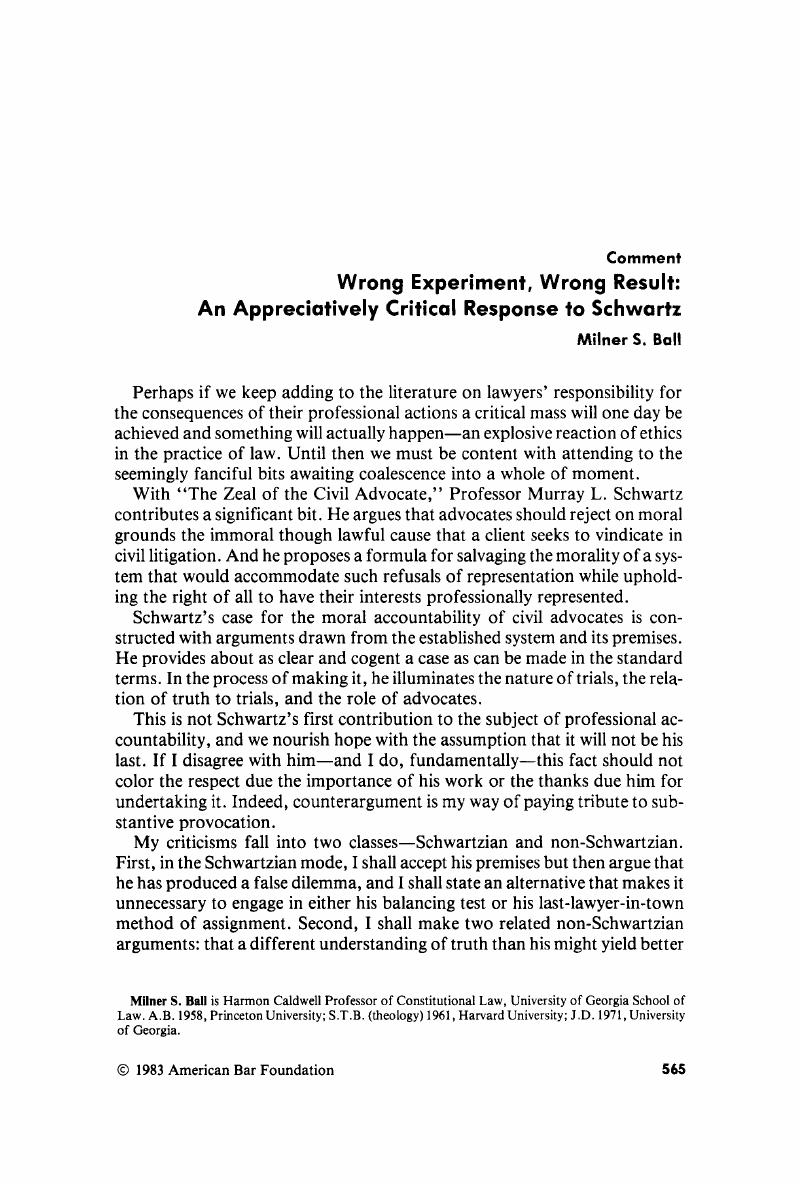No CrossRef data available.
Article contents
Wrong Experiment, Wrong Result: An Appreciatively Critical Response to Schwartz
Published online by Cambridge University Press: 20 November 2018
Abstract

- Type
- Comment
- Information
- Copyright
- Copyright © American Bar Foundation, 1983
References
1 The problem of paying fees for representation in truth ascertainment, as compared to paying fees in a gamble on winning, could be solved in a variety of ways. The simplest solution would be for civil advocates—given what Schwartz says is the rarity of such cases—to charge no fees for representing the immoral but legal cause. It would be a way of holding one's moral nose so as to comment symbolically on the immorality of the client's action. Another solution would be to remove from the bar the private business monopoly on representation in public courts. The latter solution is likely to be regarded as carrying morality to excess.Google Scholar
2 On the treachery of the balancing test as the standard climax of the standard-form law review article, see Tushnet, Mark, Truth, Justice, and The American Way: An Interpretation of Public Law Scholarship in the Seventies, 57 Tex. L. Rev. 1307, 1335 (1979).Google Scholar
3 This is not a cop-out statement, i.e., it does not immunize me from the responsibility to give a fuller statement of alternatives. My first efforts at a more complete account are available elsewhere. With respect to the specific issue of adjudication, see D. Robert Lohn & Milner S. Ball, Legal Advocacy, Performance, and Affection, 16 Ga. L. Rev. 853 (1982); Milner S. Ball, The Promise of American Law: A Theological, Humanistic View of Legal Process 42-94 (Athens: University of Georgia Press, 1981). With respect to the conceptual framework, see id., Of Rocks and Dams, PVC and Poetry: Conceptual Metaphors for Law, Ga. Rev., spring 1982, at 7; id., Don't Die Don Quixote: A Response and Alternative to Tushnet, Bobbitt, and the Revised Texas Version of Constitutional Law, 59 Tex. L. Rev. 787 (1981).Google Scholar
4 Hilary Putnam, Reason, Truth and History xi (Cambridge: Cambridge University Press, 1981).CrossRefGoogle Scholar
5 This view of adjudication gives much wider scope to human dignity than does Schwartz's view. Human dignity becomes the subject of the performance. Accordingly, a way is opened to understand the exclusionary rule as truth aiding rather than truth defeating. See Ball, The Promise of American Law, supra note 3, at 78–80. If the advocate is to be understood, at least in part, as actor-producer, then a chief ethical question is what it means to cause the performance to “work,” the verb employed by artists to describe what they regard as a successful artistic achievement.Google Scholar
6 Ernst Bloch, 1 Das Prinzip Hoffnung 242 (Frankfurt am Main: Suhrkamp Verlag, 1959) (“Das Faktum ist eine geschichtsfremde Klotzmaterie”).Google Scholar
7 Lohn & Ball, supra note 3, at 856, 858–60.Google Scholar
8 I believe that a due process interest or some other interest—equally weighty if not constitutional—could be given as the issue even if Schwartz were able to put a purely “private” case, i.e., one in which the state is not implicated directly or indirectly. Also, I should add that an attorney representing a manufacturer of Saturday Night Specials would properly have in view not the continuation of manufacture but a morally and legally acceptable means for closing it down, as, e.g., through exercise of the power of eminent domain.Google Scholar
9 ABA's Model Rules Of Professional Conduct, Preamble: A Lawyer's Responsibilities (adopted Aug. 2, 1983).Google Scholar
10 James B. White, The Legal Imagination: Studies in the Nature of Legal Thought and Expression xxxiii (Boston: Little, Brown & Co., 1973). See also id. at 807.Google Scholar
11 Matt. 2942–46Google Scholar




